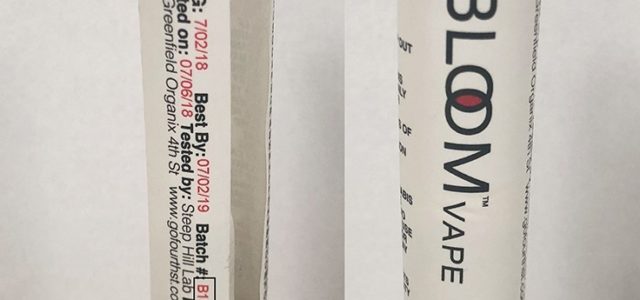The Bloom Brand and Greenfield Organix 4th St. Voluntarily Recall Cannabis Product Batch in California, Citing Pesticide Myclobutanil
July 26, 2018 MJ Shareholders


This article originally appeared in the July 2018 issue of Cannabis Business Times. To subscribe, click here.
Cannabis crops growing under naturally irrigated and fertile conditions thrive in direct sunshine as they have for millennia. The selective pressures of marijuana prohibition increasingly forced illicit growers to look for closets, attics, basements and bedrooms in which to grow their crops, while their prolonged trial and error eventually made it feasible to produce high yields of very potent sinsemilla flowers in artificial environments. Many now-legal growers still follow the prohibition manuscript and continue to expand their indoor grows into ever-larger warehouses and dedicated indoor grow facilities that rely on supplemental lighting and an array of other specialized equipment.
Indoor cultivation has allowed for the mass expansion and present-day diversity of the cannabis industry, providing a myriad of safe and productive growing environments. These environments have supported a plethora of modern sinsemilla varieties that have been multiplied and widely distributed by growers and breeders worldwide. Along with the possibility of harvesting multiple crops each year, indoor growing brought the joys of sinsemilla horticulture to virtually every corner of the globe and made production of high-quality cannabis available to every potential enthusiast.
Indoor growing conditions also engendered the preservation of the countless cultivars available today. Cannabis is an annual plant, which survives as seeds during the long, cold winter months, to sprout again in the spring, and complete its life cycle by autumn. Growers generally lack true-breeding seed stock, and without the now-widespread ability to create and control indoor growing conditions, many cannabis varieties would have been irretrievably lost. Many clonal varieties we enjoy would not be available today had we been unable to protect and overwinter vegetative cuttings in indoor grow rooms. However, many modern varieties were selected specifically for indoor production, do not perform well outside and, without the electric grid, would not be favored by growers.
Indoor Cannabis and Its Ripple Effect
Indoor growing is costly, however, and because of that, combined with prohibition pressures, high-quality indoor sinsemilla flowers have always been an overly expensive agricultural product. Illicit indoor sinsemilla growers, who were most often limited by high production costs and relatively small facility sizes, were forced to charge their customers a premium for the lingering threat of arrest during prohibition. But, as long as prohibition ensured less sinsemilla was being produced than consumers wanted to buy, demand exceeded supply, the retail price remained high and the electric bills were reliably paid.
Indoor growing started simply as a successful way to hide crops from cops, and today’s indoor growing is largely a residual effect of vigorous prohibition; but sinsemilla growing is already legal (or de facto legal) in many jurisdictions nationwide. While growers’ risks are increasingly minimized, marijuana supplies have reached all-time highs in many markets, and prices have reached all-time lows. In addition, sinsemilla flowers are becoming raw material rather than only end products, and extracts and isolates are now flooding the cannabis market.
Cannabis crops growing under natural sunlight might require supplemental soil nutrients and sufficient water, but few, if any, additional inputs. Creating paradise indoors is costly in several ways. In addition to expensive infrastructure, modern-day sinsemilla crops grown in artificial grow facilities require commercial lighting, heating, air conditioning, dehumidification, fans and carbon dioxide supplementation, which all rely on fossil fuels. Prohibition transformed cannabis from a sun-grown crop, cultivated by traditional farming techniques with a minimal carbon footprint, into a significant environmental concern.
A minority of growers are blessed with living in climates favorable to greenhouse and outdoor growing, and the remainder still make do by practicing their tried-and-true indoor-production strategies. Following the lead of every other major agricultural crop, cannabis production is slowly shifting to locations where it is economically best suited—with some agriculture companies favoring greenhouses and broad-acre fields in regions with abundant water, sunshine and low labor costs. We envision that much of production will return to regions worldwide where cannabis has been grown successfully for centuries.
To read the full article in Cannabis Business Times’ July 2018 issue, click here.
Top photo: RylandZweifel | iStockPhoto
MJ Shareholders
MJShareholders.com is the largest dedicated financial network and leading corporate communications firm serving the legal cannabis industry. Our network aims to connect public marijuana companies with these focused cannabis audiences across the US and Canada that are critical for growth: Short and long term cannabis investors Active funding sources Mainstream media Business leaders Cannabis consumers










